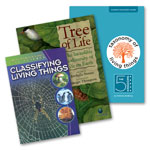A Science Discovery Guide from Blackbird and Company, Taxonomy of Living Things: The Five Kingdoms guides students through research and writing using two source books plus additional research from other sources. The two required source books are Classifying Living Things by Darlene R. Stille (48 pages) and Tree of Life: The Incredible Biodiversity of Life on Earth by Rochelle Strauss (40 pages). Both books are based on an old-earth, evolutionary perspective. These books are both heavily illustrated in full-color, although the illustrations for Tree of Life, which were created by Margot Thompson, are especially beautiful.
Taxonomy of Living Things directs reading, research, and writing assignments with space for written responses within the guide itself. The guide is set up for students to work for about two hours a week for eight weeks. Assignments are arranged by weeks. Of course, you could have students complete more than one lesson per week if they have time available.
Lesson gradually take students from simple responses such as writing definitions and describing things into answering questions based on their assigned reading. Students are gradually challenged to assimilate information from more than one source and then to search for information on their own. Written responses range from filling in charts up through writing one or more paragraphs on topics such as Carolus Linnaeus or the characteristics and behavior of any Monera the student chooses to research. Written responses become lengthier as students progress, although none are required to be more than a few paragraphs.
As you can tell by the size of the resource books, the amount of reading is very manageable for students about fourth grade and above. Additional research and reading can easily be completed on the Internet, but that might be a bit more challenging for fourth graders. The guide gives assignments, but it offers no instruction as to how to complete assignments. Parents or teachers might need to help students understand what they need to do for each assignment. The research and writing seems to make this study most suitable for grades five through eight. Younger students might complete the study with more assistance from a parent or teacher. On the other hand, junior high students who have not yet learned to do research should benefit from this gentle, guided approach.
This course is designed to be supplemental rather than as a complete course. The study serves a number of purposes. Students learn about the classification of living things, contributing to education in science. However, the guided reading, research, and writing helps students learn how to read for information and then assimilate and report on what they have read. This is valuable work in language arts. Overall, I see it as being most valuable for teaching students how to research and write from non-fiction sources.








